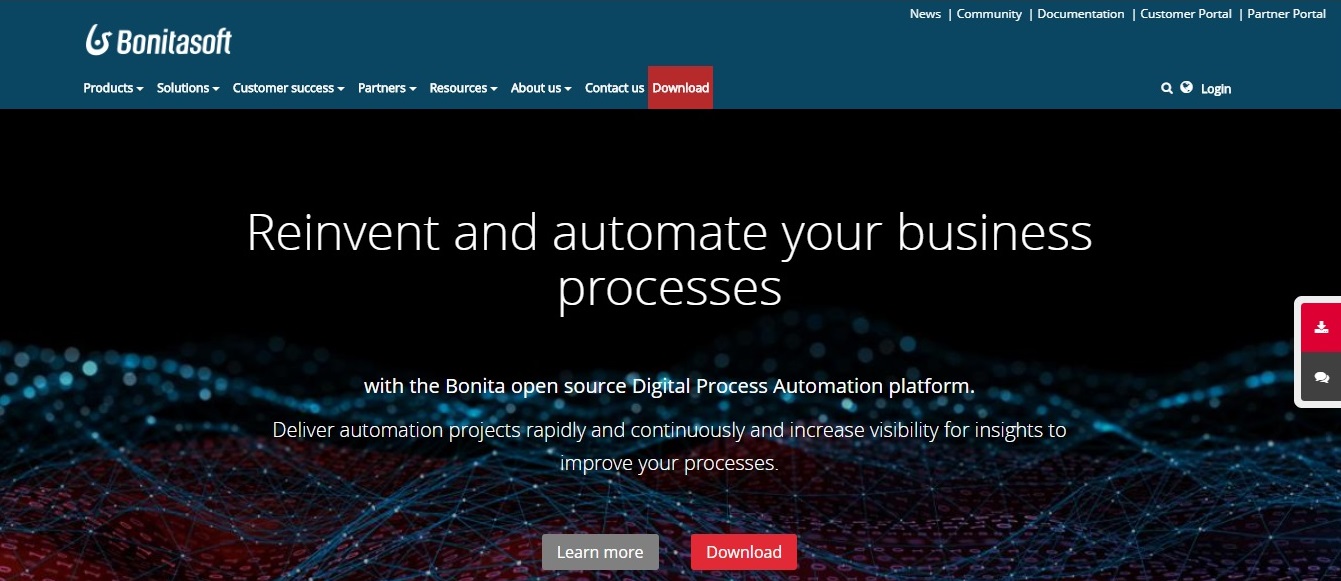They say that humanity’s biggest inspiration for order, coordination, and efficiency is mother-nature herself. Think about a colony of bees. With over a thousand worker bees diligently executing tasks in its position of the hierarchy, it’s no wonder that honey is produced so smoothly. The tasks executed by these bees may be distinctly classified as being one of the most efficient workflows.
Over many centuries of existence, humans have consistently evolved and tried to understand the implementation of order as part of their everyday routine. Whether it’s personal, like activities done after getting up from bed, or if it’s professional – like setting up shop to sell fish at a market – the thought at the forefront of establishing efficiency in everyday life has been Order.
This, through the industrial era as well as the turn of the 20th century, took center-stage as workflows in busy factories and steel bastions. With the evolution of technology and scientific progress in the field of computing – order and efficiency have taken on forms such as the workflow system.
Workflow Management Systems have today become the backbone of many trailblazers in multifarious industries, and their importance continues to grow.
Defining Workflow Management
To understand what workflow management actually is, let’s break the concept down in simpler terms. A workflow is defined as a series of steps which, through the input of data and subsequent processing sequentially in the order defined, results in the completion of a specific task.
Operationally, workflows represent the mechanism of getting work done. Take, for example, the act of finalizing a vendor for a specific project in a company.
Workflows will need to be created for inviting tenders for the project, inspecting the vendor’s capability and capacity for the task, ensuring financial viability is signed off on the project, sending invoices post the selection of the vendor, contract finalization, post assignment follow-ups, as well appropriate documentation.
In many corporate apparatuses world over, workflows aren’t as simple. There exist multiple ones, each which focus on the completion of a task. These independent tasks together result in the completion of a bigger organizational objective.
A simple workflow system consists of predefined business rules and designated human tasks, which results in error-free outcomes.
With the rise in technology and automation, the necessity of workflows to accomplish complex processes with minimal human intervention has been greater than ever. The ever-changing business environments required robust mechanisms to achieve efficiency in business processes, and this is where the Workflow Management Softwares/Systems arose.
What is Workflow Management Software?
Workflow software (WfMS) can perform a series of automated actions in business processes to improve efficiency, focus, and accountability. Workflow Management Software can design and execute large projects with customized business applications. With the use of an optimized Workflow tool, you can start organizing your business into a systematic framework.
Essentially, business processes today require a stern degree of automation. Workflow Management software ensures that the most rigorous tasks are executed without much ado.
Types of Workflow Management Tools
There are essentially three types of workflow management tools. Let’s have a look at these.
Human-Centric Workflow Management Systems
Creation of Business process management tasks and methodologies that involve significant human input, because only people can perform them, in the chain and thereby designing automation processes to support these tasks (e.g., Writing a proposal, Data analysis reports, etc.).
Document-Centric Workflow Management Systems
Used when documents hold significant value in the processes of organizations. The flow of documents through different processes and activities it is used becomes central to the plans of the business process to improve the company’s efficiency. In this case, the product of a process on one document at any stage of the process becomes the input to the next stage. Hence document standardizations and acceptable inputs must be present to preserve formats.
Most common activities that consider a document-centric system include document approval and review, transcription, and translation.
Integration-Centric Workflow Management Systems
These often involve tasks and functionalities where the contributions of human beings are minimal at best. Iterative and sequentially executed repetitive tasks fall under this purview.
Workflow Systems – Then and Now

Who uses Workflow Management Software?
Workflow management software solutions are used by individual users or corporations who need to keep track of real-time events with the purpose of processing, reporting, and executing a variety of tasks, which may or cannot accommodate consistent human intervention.
Examples of Industries using the workflow include the food and beverage industry, companies such as Dominos and Pepsi, while the airline industry does rely on the workflow for efficient business process handling.
Some of the world's biggest banks rely on successful workflow tools to ensure transaction reliability.
Consequences of Not Having a Workflow Management Software
With the ever-increasing load of concurrent processes to be kept track of, having workflow management systems that make businesses smoother has become the order of the day. Not preparing accordingly can have negative effects!
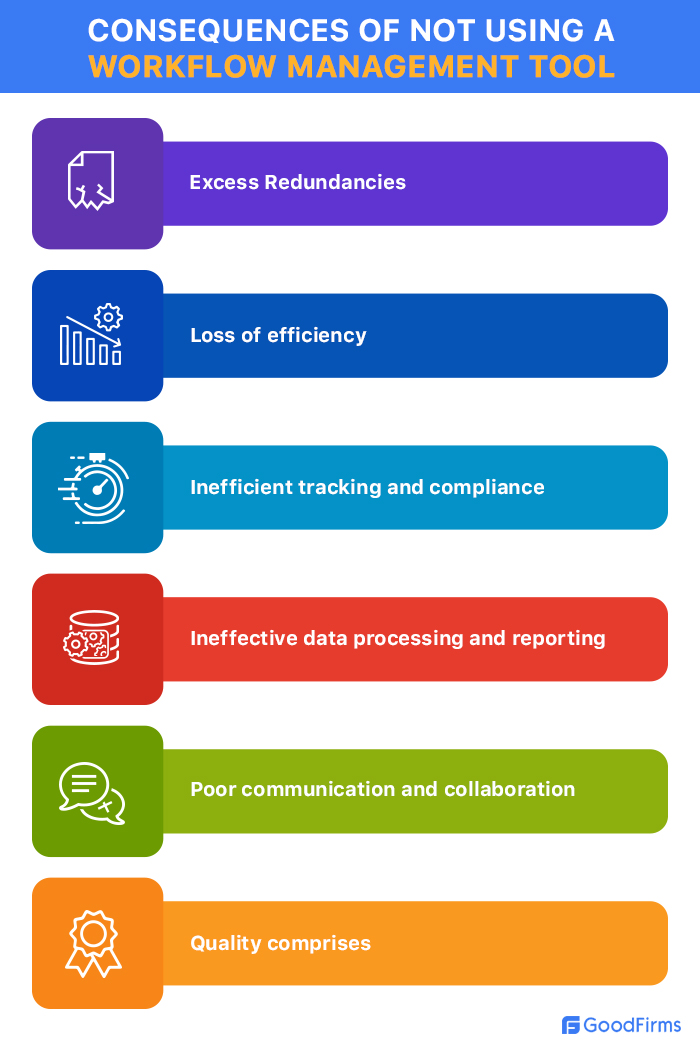
Advantages of Workflow Management Software
Workflow Management systems grew in importance throughout the ‘90s and into the ‘00s, once professionals in the IT sector realized its significance alongside the vast globalization of productivity. Here are a couple of benefits of the modern Workflow Management software -
- Increased efficiency through streamlining processes
- Effective compliance and audit tracking
- Accurate data reporting and insight
- Better communication and collaboration
- Product and process quality improvements
- Enhanced business planning
- Improved business strategy
- Increased customer satisfaction and loyalty
- Reduced redundancy and resource wastage
- Lowered process risks
Functions Executed by a Concise Workflow Management Tool
Access Controls
Just like the name suggests, access controls regulate the interactions individuals in an organization can have with a selective resource. This becomes most important when sensitive data and the non-overlapping processes must be kept apart from different users.
Automate Business Process
Allowing minimal human interaction in some processes in business actually aids in greater productivity, while reducing cost. Workflow management systems must contain,
Calendar Management
From the tracking of events per day to scheduling meetings between personnel and not to forget, hosting reminders, Calendars have become near synonymous with business efficiency. Hence, an effective Workflow management system will host and accomplish some basic calendar Management functions.
Compliance Tracking
Following up with all documentation and procedures to ensure no rules and regulations were broken in the follow-through of the process.
Document Management
The genesis for today’s workflow management systems arose in the necessity of maintaining thousands of documents online and offline in the corporate world. With the boom of business and the subsequent necessity of recording thousands of tasks per day, effective documentation management has been one of the key functionalities that workflow management systems achieve success in.
Enhanced Communication
Communication is often regarded as the backbone of efficient organizations. Despite this, miscommunication between departments or teams essentially under the umbrage of the same organization can single-handedly be the cause for the disruption in performance. A good workflow management system minimizes the gap in communication and allows strong collaboration between teams.
Forms Management
An ever-increasing reliance on storing data for different processes and of different types has led to the necessity of effective forms management software. Through forms, documentation, and subsequent processing of data becomes a child’s play for the system, while minimizing human intervention to process them, becomes the norm, especially when data is stored to the tune of millions of bytes every day in an organization.
KPI-based Reports
Multiple processes need KPIs to be recorded simultaneously or instantaneously. Keeping track of all of them together makes productivity egregious. It is here that KPI indicators, all of them visible on a programmed dashboard, adjustable by the user, makes workflow management systems a boon to use.
Notifications and Reminders
As discussed in the calendars section, workflow management systems play a savior to schedule on an individual basis. Whether it’s a reminder to execute a task at a particular time or if it’s automated progress checks that keep the users updated on independent processes, workflow management systems give users a significant advantage in-process monitoring like they never take their eyes off the ball.
Reporting and Analytics
Crunch decisions are often made by falling back on the strength of the data-backed analysis. Reporting the effect of these decisions and also carrying out further data analytics falls under the purview of most Workflow Management Systems.
SLA Status Indicators
With the increasing importance of software dashboards, SLAs have become to be relied on. These indicators aid users in deciphering the progress of a task in accordance with its importance, such that users know which objective needs to be achieved before others.
Let's now go through details about one of the most popular workflow management software - Wrike.
Wrike
Wrike is a cloud-based workflow management software that delivers powerful automation empowering your teams to collaborate efficiently across multiple departments and have 360-degree visibility over different projects running within an organization. It helps companies to improve productivity by establishing a systematic approach while managing various workflows. It helps your team maximize its performance, resulting in improved customer experiences and accelerated business growth.

(Source: Wrike)
Key Features
- Provides customizable dashboards, workflows, request forms, and more to equip teams with the exact solutions they need
- Allows sharing files and shortens approval processes with visual proofing resulting in enhanced productivity and collaboration within teams
- Eliminates silos between different departments by providing visibility to real-time information enabling smart and informed decision making
- Enables instilling ethical practices within an organization as it includes security capabilities that prevent fraudulent and malicious activities
- Includes templates built for specific purposes that help in speeding up some standard processes like event management, onboarding employees, order fulfillment, and more
- Provides automated insights over workloads that help in better resource management and achieving required productivity
- Enables easy access to customized reports that help making smarter decisions and implementing smoother workflows
This article will further discuss the 7 open source and free workflow management software for your business needs.
Top 7 Open Source and Free Workflow Management Software
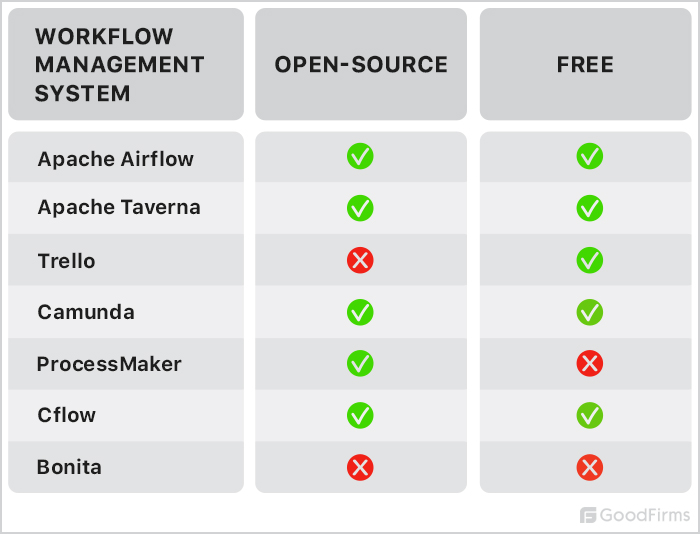
1. Apache Airflow
With a focus on creating, monitoring, and managing workflows, Apache’s free and open-source Airflow platform is a go-to workflow management tool. Constituted of Directed Acyclic Graphs (DAGs), it helps users schedule, program, and automate the flow of data through nodes.
The pipelines only represent the direction of data movement, while one node’s (task) output, is usually the input to another node. The acyclic nature of the graph indicates that data cannot flow back between nodes. The process must be completed or halted and restarted for the workflow to complete all tasks.
The airflow workflow management platform was built on four important principles, which also translate to some of its most important features as follows.
- Dynamic – Dynamic creation of pipelines, CODED in via python as initiated, as well as DAGs themselves to ensure smooth process creation in the Airflow environment.
- Elegant – A smooth interface and enriching User Interface (owing to the python script), combined with what Apache terms “lean” pipeline configuration allows for a quick and almost flawless workflow creation.
- Extensible – No need to follow the predefined set of operators and variables in the airflow environment library. A user can create their own set of the above, aiding their level of abstraction and understanding.
- Scalable – Imagine a workflow with over a hundred individual processes! Airflow’s characteristics allow a user to envision an environment that fits multiple scenarios, owing to its scalability.
- Integration – Multiple Amazon Web Services (AWS), Google Cloud applications, and Microsoft Azure functionalities can be integrated into the airflow workflow environment.
- Easy, concise monitoring and reporting
- Multiple Graph views in the Environment - Includes tree view, Graph View, and DAG View for minute analysis of processes.
2. Apache Taverna
While Apache Airflows can be used to create regular workflows, Apache Taverna is a free and open-source workflow management system that caters to the creation of scientific workflows. In essence, it is a workflow management tool specifically aimed at the scientific community.
The Taverna suite, as it’s better called, is a combination of the Taverna engine, the Taverna Workbench, and the Taverna Server. These components working together aid scientists with limited working knowledge of computing and skim on resources to essentially build complex data workflows (and perform analysis on them) from a variety of public and private sources, involving distinct fields such as geography, medicine, and sports analytics.
The workflow tool is platform-independent, which means it can be accessed from a variety of operating systems.
Features
- Command-line execution to allow quick and easy GUI-less Workflow monitoring
- Remote access to workflows using Taverna Server
- Integration of a wide variety of scientific and non-scientific service providers; e.g., BioMart, SoapLab, R, Excel Spreadsheets
- Enough versatility to open workflows in a web-browser.
- HTTP authentication necessity ensures protection for all users
- Optimizing and monitoring Workflow progress
- Extensive customer support
- Share self-created workflows and analyze different ones using myExperiment services
- Exceptional debugging tools present
- Rich, diverse set of pre-loaded workflows alongside the option to create from scratch
- Easy-to-navigate and feature-heavy workbench environment
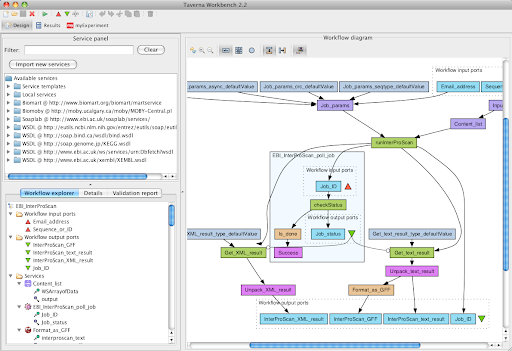
3. Trello
Trello is a visual, free workflow management tool. It consists of a list of cards, which in turn contain a set of to-do activities for a team. Trello’s ambition is to showcase greater team collaboration and ease of project management. Owing to a cascading view, cards can actually be allotted significant parameters such as date of task completion, names of team members, etc., for productivity purposes.
You can use Trello to organize and prioritize personal and professional life in a fun, flexible, and rewarding way.
Features
- Compact and easy to use the card system
- Easy collaboration between departments
- Visibility and accountability established within the workflow
- Intuitive and easy to use Workflow editor
- Notification and reminders
- Availability of rule-based triggers to increase automation of tasks
- Customizability of cards
- Integration with third-party applications (DropBox, JIRA, etc.)
- Readymade templates of cards for different processes and functions in different industries
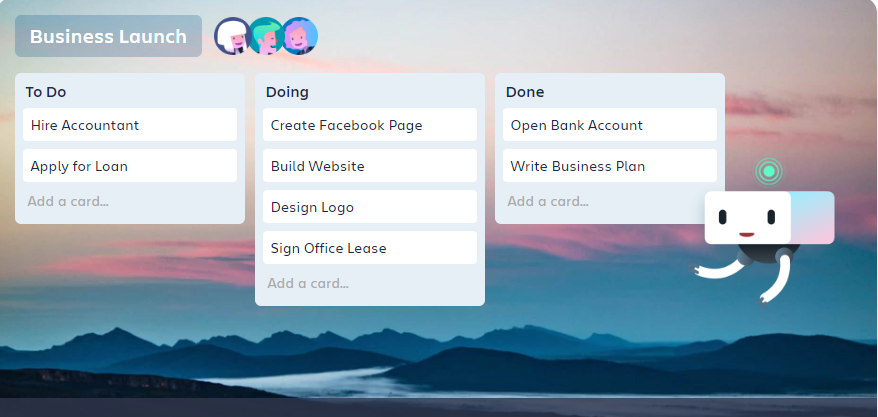
4. Camunda
Camunda is a free and open-source workflow management tool that allows businesses to achieve digital transformation through the power of automated tools and efficient workflows. Built on three fundamental principles of design, automation, and improvement, Camunda ensures the process of designing workflows becomes simpler and less taxing as it once may have been. The workflow management system has been envisioned to ensure agility in handling workflows for complex organizations, while data visibility remains key between actors. Built on a lightweight Java Application Program Interface (API) stack, the platform is robust and easily scalable.
Features
- Better performance through the separation of runtime and historical data
- Efficient sharing of databases by multiple entities to ease scalability
- Support of all BPMN 2.0 symbols to represent complex tasks that are easily understandable
- Complex Decision table integration available with workflows, to enhance business rules-based decision making while increasing output
- Creation of shared, inter-departmental workflows alongside conversion to HTML and XML file types
- Easy integration of Camunda plug-ins and technologies
- BPMN Modeler allows the creation of executable files for multiple BPMN and DMN engines
- Existence of predefined configuration to allow customized and low code template for workflow designs
- Highly detailed dashboard, Cockpit that serves to quickly identify, analyze and resolve workflow errors
- Rigorous authorization checks via administration software to safeguard sensitive workflow processes
- Detailed task assignment, user communication and progress tracking using the BPMN 2.0 user task interface, Tasklist
- Rigorous analytics tools and dashboards with a clear focus on reporting the efficiency of workflows
- Process tools such as BPMN 2.0 heat maps, alerts, and variety (model) testing to ascertain optimum workflow fit for business processes
- Cloud-integrated, easy access from multiple platforms

5. ProcessMaker
ProcessMaker is an open-source workflow system that allows BPM users to generate low-code workflows and design complex processes faster than other similar tools, especially for enterprises. The ProcessMaker workflow consists of an agile BPM technology where users can just drag and drop elements on the environment interface to quicken process ideation and analysis.
Features
- Easy and rapid to implementation of workflows
- Extensive portability of workflows across teams
- Integration of a variety of third party applications and services (Eg. DropBox, Salesforce, etc.)
- Cloud-hosted BPM software to ensure accessibility on AWS for enterprises
- White Label software – essentially allows companies to use ProcessMaker BPM functionalities as their own after customization
- User authentication protocols to strictly protect sensitive workflows
- Screenbuilder allows easy building of web-based and interactive forms.
- ProcessMaker RESTful API and complete Software Development Kit allow for resourceful workflow designs.
- Easy access to a robust database using API.

6. Cflow
Cflow is a cloud-based (hosted on AWS), open-source workflow automation software. It is essentially a code-free workflow management tool, with the software operating on assets of predefined library templates of essentially used workflows for organizations of different dimensions.
Features
- Resilient and reliant drag and drop software interface
- Custom Inbox to preserve and denote all available workflows in the environment
- Easy integration of over 1000 third party applications (e.g., SAP, Zapier, etc.)
- Visual workflow designer with predefined, industry-specific templates
- Central dashboard to track all process performance and increase the efficiency of decision making
- Robust notification setup to alert multiple users of workflow progress
- Excellent document management
- Intuitive mobile application to build and monitor workflows
- Ensures compliance details are followed by creating an audit trail of all processes
- Advanced authentication techniques alongside encryption for tasks and processes
- Customizable decision-maker engine that can easily be implemented across workflows
- Allows for easy linkages between multiple processes for increased collaboration between departments.
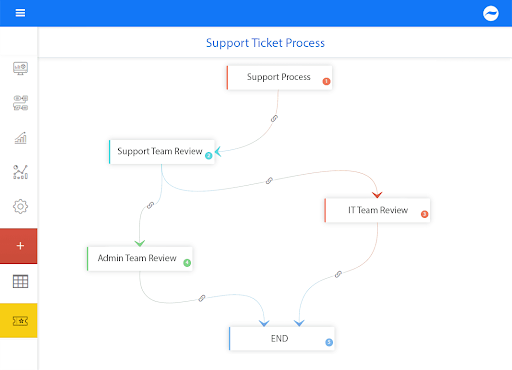
7. Bonita
The Bonita Platform is a workflow tool, and the business process management (BPM) tool allows enterprises to create and monitor process-based implementations within the organization. It is a cloud-based, open-source system that is used to achieve efficiency or digital transformation of business processes.
Features
- Rapid and agile development of processes using the Bonita studio
- Inter-linking of processes to allow users access via web portals and applications
- Connect to databases, social platforms, web services, and SaaS offerings
- Integration to enterprise systems such as ECMs, CRMs, ERPs
- Citizen developer application composition
- Customize, modify, and personalize processes with out-of-the-box features
- Ability to integrate many third-party applications
- Manage a plethora of tasks with Bonita Portal
- Efficient reporting on processes
Conclusion
In today’s world, where consistent process improvement is the norm, workflow systems have been continuing to deliver. Research shows that inefficient workflow systems, let alone non-implemented workflows will cost companies dear in the long-term.
However, when implemented correctly, the workflow software delivers results in the form of better productivity (all resources considered), revenue growth, and multi-disciplinary collaboration.
Choosing the right workflow tool is incredibly important. This article has discussed the best available options in the market. One can select for one's business needs any of the free and open-source workflow management software discussed in this article after careful analysis of the available features that they offer and then aligning them with one's requirements.
We will love it if you share your views about the article in the comments section below. If you have utilized any of the top workflow management software mentioned above, then do share your feedbackwith us.
If you wish to see the features of any other workflow management tools or any other software category other than Workflow Management software, then do look at our software directory.

